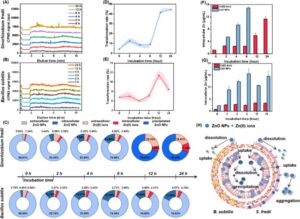
“Real-time monitoring of culture medium- and species-specific transformation of zinc oxide nanoparticles in bacterial systems using coupled CyElFFF-ICPMS,” authored by Weichen Zhao et al., was recently accepted in Microchemical Journal.
The article outlines the use of an online-coupled cyclical electrical field-flow fractionation and inductively coupled plasma mass spectrometry (CyElFFF-ICPMS) system for the quantification and characterization of the promising nanoagrochemicals of zinc oxide nanoparticles (ZnO NPs) and Zn(II) ions. Using the CyElFFF-ICPMS system, bacillus subtilis is found to stabilize ZnO NPs while sinorhizobium fredii promotes extracellular ZnO NP aggregation and dissolution. After 6 h, intracellular transformation significantly diverges. These findings demonstrate that the stability, transformation, and intracellular fate of ZnO NPs are highly governed by bacterial species-species interactions. The intracellular transformation and distribution of ZnO NPs in bacterial systems is displayed in the figure and the full article can be found at https://doi.org/10.1016/j.microc.2025.114926.
